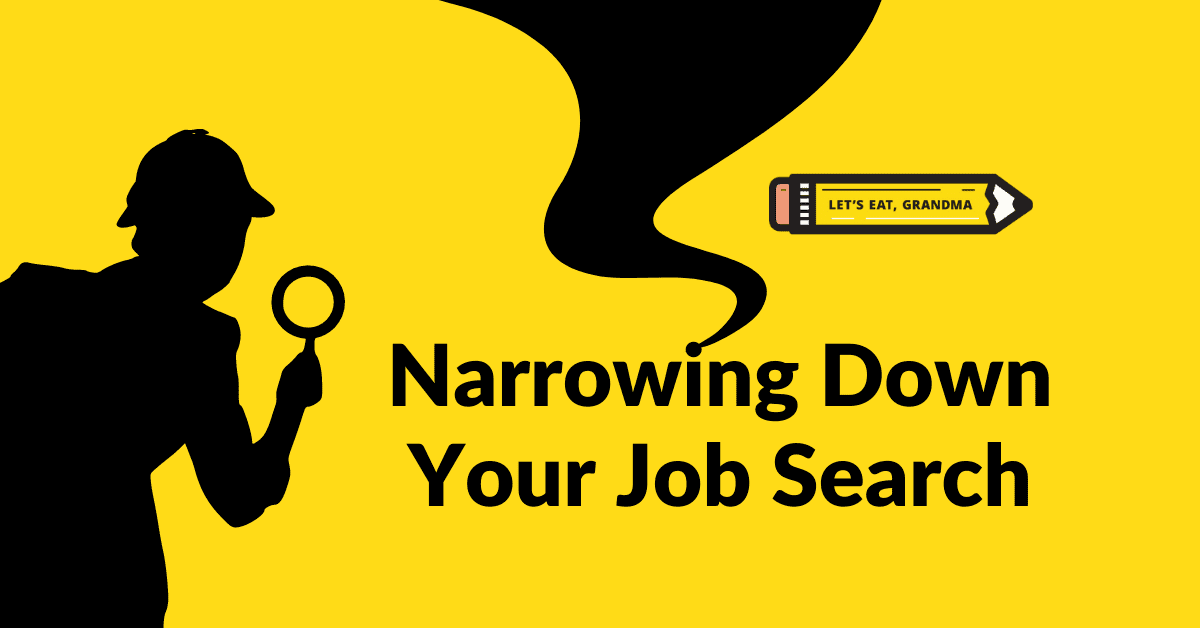The Job Search is Overwhelming: Here’s How to Narrow Your List

Looking for a job can be especially difficult when you don’t know what you’re looking for. Here’s our guide to getting started when you don’t know where to start.
By: Grace Mitchell | Contributor for Let’s Eat, Grandma
So you’re ready to jump into the job search, but wait! There are literally thousands of job postings out there. How can you know where you’ll be a good fit?
Online job boards give us more options than ever before, but too many choices can also lead to paralysis and an increasing sense of dread.
Remember that iconic scene from The Notebook, where Noah asks Allie what she wants, and she keeps shaking her head without answering?
This is exactly the sort of emotional distress you don’t want when going into your job search.
Not only will it make your search more difficult, but you’ll likely get swept into a decent-sounding job that doesn’t actually fulfill you.
Knowing what you really want in a job requires some forethought, but following this three-part strategy can take you from uncertain to an Elle Woods level of confidence and drive.
Ready for more job search help?
Sign up for a free Senior Writer Resume Critique to see what’s holding you back from landing interviews. One of our top professional resume writers will give you personalized feedback on the top 3 items you can improve based on our expert practices!
Part 1: Self-Reflection
There are plenty of “good jobs” out there, but your goal here is to find a good job for you. Finding that requires a deep awareness of your goals, values, likes, and dislikes. In other words, it’s time to step away from the job board and do some self-reflection.
What are your Goals?
Our partner, career coach Lisa Lewis Miller, came on our Career Warrior Podcast to define four pillars for deciding your career direction: strengths, interests, personality, and lifestyle goals. The most important pillars for you won’t necessarily be the same as for someone else, so, as you consider these, consider the order they fall in within your own life.
Strengths
Your strengths are the on-the-job duties and assignments that engage both your curiosity and ability, those tasks that you would gladly do all day, every day. Keep in mind that a strength isn’t just something you’re good at. As Lisa points out, if your resume highlights tasks you excel at but hate doing, the jobs you attract will likely be full of those same loathsome activities.
Interests
What work do you want to be doing in the world? Are you passionate about food justice? Music? Animals?
Lisa recommends either seeking out a job that allows you to work with these passions or a job that gives you the flexibility you need to do the hobbies or volunteer work that feeds your soul. Either way, you’ll be more energized at work because you’re taking time for what matters most to you.
Personality
Are you an introvert or an extrovert? Do you want your coworkers to treat you like family or strictly like colleagues? Considering your personality at work will help you know what to look for in a company. (We’ll get to how to look for these traits in part three.)
Lifestyle Goals
Would you rather have a job that maximizes income or adventure? Flexibility or career training? Could you live with a lower salary if the benefits are great? You should also consider your current cost of living. What salary is needed to live the way you want to live?
Values
In addition to the four pillars above, CWP guest Scott Miller (no relation) recommends taking time to consider your primary professional and personal values: both where they overlap and where they cause tension. In addition to these, he recommends thinking in reverse order: consider what position you want to be in when you retire and work backward from there until you arrive at your next step. With your “40-year plan” in mind, you’ll be better equipped to make the best career decisions to help you get there.
In thinking through your pillars and values, be sure to take your time and write them down! Having what’s important for you in your career on paper will help you to know when a job fits the bill.
Part 2: Contemplating Your Career Path
Now we get to the choose-your-own-adventure portion:
If, after your self-reflection, you’re not sure if you want to stay in your industry/field, start here.
If you’re sure you want to stay in your industry/field, skip ahead to part 3.
How much do you want to change?

It’s never too late to choose a new career path. Photo by Jens Lelie on Unsplash
Is it time to transition into an entirely new career, or are there just aspects of your work that you need to change? If the latter applies to you, you may be in need of a career pivot. The author of this article loved the writing she was doing but recognized that freelancing would be a better fit for her than the company she had been working for.
Similarly, you may find yourself in a position that isn’t quite what you want but comes pretty close. Consider both what you love and what you would change if you could (and then assume that you can change these things)!
Use informational interviews
Informational interviews are an important resource when transitioning into a new career. The best way to know if a career aligns with your values, strengths, and other personal goals is to talk to someone who’s doing the work about what it looks like day-to-day. Don’t just ask about their satisfaction on the job but get into the specifics of what makes it rewarding or dissatisfying for them. After all, they have their own strengths and goals that might not align with yours.
No experience or “too much” experience? No problem!
Whether you’re wanting to transition into a career where you have limited experience or you’re twenty years into your career and need a change, don’t let your experience level stop you! Focus on transferable skills and the experience you do bring to the table. And if possible, find ways to gain experience in your desired field, through internships, volunteering, and/or certifications.
Part 3: Determining Your Best Fit Company and Title

Reflect on your experiences and research lots of job descriptions to determine what roles match your skillset and interests. Photo by Brooke Lark on Unsplash
Now that you’ve reflected on what you want and the path it’ll take to get there, you’re in a good place to get into the nitty-gritty of job titles and company cultures.
Finding the right title
Within disciplines, there can be a big difference between job titles, so it’s important to consider both what tasks you want to do and what company you’d want to do them for.
For instance, a Director of Marketing and Events has a lot more event planning to do than the average Head of Marketing. If you’ve hated planning events in your current job, the former is not likely to be a good fit, but the latter might be.
Reflect on your skills and read through plenty of job descriptions. Since you have a clearer idea of what you want, this is the part of the process where looking at these can be useful again.
Finding the right place to work
You may want to research and consider in-demand skills and jobs, especially if you haven’t looked in a while. Using a resource like Zeit can help you discover where your skills align with what companies are looking for.
Most importantly, take the time to research companies, and make a list of your target companies and titles. Having these laid out on paper will help you to find that sweet, sweet overlap between the jobs you want and the companies you admire.
The company description from the job description likely won’t give you enough information to know if somewhere is a good fit. (How many companies have you seen claim they’re “an exciting, growing company where you can make a significant impact?”) You can gain a better insight by talking to people who work there, looking through the company website, and searching through sites like Glassdoor.
Putting It All Together
Once you’ve gone through this process and have an idea of what you’re looking for, it’s time to start working on your documents and building a networking strategy! Now get out there and get that dream job!
Ready for more job search help?
Sign up for a free Senior Writer Resume Critique to see what's holding you back from landing interviews. One of our top professional resume writers will give you personalized feedback on the top 3 items you can improve based on our expert practices!

